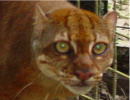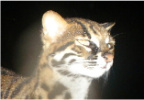Carnivore researchers have captured the first footage of the Sunda clouded leopard (Neofelis diardi) in Malaysia. The island’s largest predator was only proclaimed a unique species in 2006 when genetic evidence and analysis of its markings proved it was distinct enough from its mainland relative—the clouded leopard (Neofelis nebulosa)—to be considered a new species. The recent classification has prompted renewed interest in this elusive and threatened cat.
The film, the first showing a Sunda clouded leopard (also known as the Bornean clouded leopard), was captured in the Dermakot Forest Reserve in the Malaysian part of Borneo. Researchers studying the cat, along with four other carnivores in the area (including four other cat species) encountered an individual Sunda clouded leopard while driving one night—a truly rare occurrence.
“For the first eleven months we had not encountered a single clouded leopard during these night surveys,” Mr Andreas Wilting of the Leibniz Institute for Zoo and Wildlife Research in Berlin, Germany told the BBC. “So every one of our team was very surprised when this clouded leopard was encountered. Even more surprising was that this individual was not scared by the light or the noises of the truck. For over five minutes this clouded leopard was just roaming around the car, which compared to the encounters with the other animals is very strange, as most species are scared and run away after we have spotted them.”
The Sunda clouded leopard is classified as Vulnerable by the IUCN Red List. It is threatened by habitat loss, which threatens the majority of species on the island of Borneo including orangutans, elephants, Sumatran rhinos. Widespread deforestation first for timber and now for oil palm plantations has resulted in incredible forest loss on the island of Borneo: from over 90 percent forest cover to 50 percent in less than 60 years.
Borneo is also home to the bay cat (Endangered), the flat-headed cat (Endangered), the marbled cat (Vulnerable), and the leopard cat.
“No other place has a higher percentage of threatened wild cats!” Jim Sanderson, an expert on the world’s small cats, told Mongabay.com. Pointing out that 80 percent of Borneo’s cats face extinction, Sanderson added that “not one of these wild cats poses a direct threat to humans.”
To see photos of the Sunda clouded leopard and Borneo’s other four cats: Photos: Palm oil threatens Borneo’s rarest cats and Saving the world’s most recently discovered cat species in Borneo.
Footage of the Sunda clouded leopard in the wild.
Related articles
World’s first video of the elusive and endangered bay cat

(11/05/2009) Rare, elusive, and endangered by habitat loss, the bay cat is one of the world’s least studied wild cats. Several specimens of the cat were collected in the 19th and 20th Century, but a living cat wasn’t even photographed until 1998. Now, researchers in Sabah, Malaysian Borneo, have managed to capture the first film of the bay cat (Catopuma badia). Lasting seven seconds, the video shows the distinctly reddish-brown cat in its habitat.
Photos: Palm oil threatens Borneo’s rarest cats

(11/04/2009) Oil palm expansion is threatening Borneo’s rarest wild cats, reports a new study based on three years of fieldwork and more than 17,000 camera trap nights. Studying cats in five locations—each with different environments—in Sabah, Malaysian Borneo, researchers found that four of five cat species are threatened by habitat loss due to palm oil plantations. “No other place has a higher percentage of threatened wild cats!” Jim Sanderson, an expert on the world’s small cats, told Mongabay.com. Pointing out that 80 percent of Borneo’s cats face extinction, Sanderson said that “not one of these wild cats poses a direct threat to humans.”
Saving the world’s most recently discovered cat species in Borneo
(04/10/2008) Last year two teams of scientists announced the discovery of a new species of clouded leopard in Borneo. The news came as conservationists launched a major initiative to conserve a large area of forest on an island where logging and oil palm plantations have consumed vast expanses of highly biodiverse tropical rainforest over the past thirty years. Now a pair of researchers are racing against the clock to better understand the behvaior of these rare cats to see how well they adapt to these changes in and around Danum Valley in Malaysia’s Sabah state. Andrew Hearn and Joanna Ross run the Bornean Wild Cat and Clouded Leopard Project, an effort that aims to understand and protect Borneo’s threatened wild cats, which include the flat-headed cat (Prionailurus planiceps), marbled cat (Pardofelis marmorata) leopard cat (Prionailurus bengalensis) the endemic bay cat (Catopuma badia) and the Bornean clouded leopard (Neofelis nebulosa).